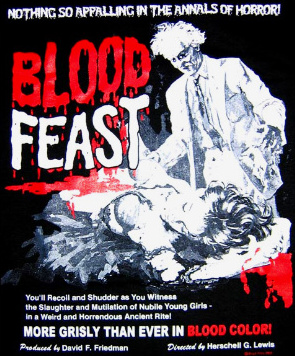
Director: Herschell Gordon Lewis
Writer: A. Louise Downe
Starring: Thomas Wood, Mal Arnold, Connie Mason, Lyn Bolton
Almost twenty years before Tom Savini drove an arrow through Kevin Bacon’s throat, a low budget detective story by the name of Blood Feast introduced audiences to a new type of experience, the splatter film. Created as a means to stay one step ahead of his contemporaries, exploitation filmmaker Herschell Gordon Lewis would spawn a new type of cinema, a no holds barred onslaught of gruesome set pieces and beautiful women. Despite its amateur acting and ludicrous story, Blood Feast would go on to become one of the most influential motion pictures of the sixties and would inspire a generation of directors and makeup artists to up the ante and give the fans what they really wanted. Its legacy would be more impressive than the film itself, not only ushering in an array of gory offerings such as The Omen, Carrie and Friday the 13th but also proving that independent movies could be as profitable as major studio releases. Half a century later and Blood Feast is as important as ever.
Lewis was born on June 15 1929 in Pittsburgh, Pennsylvania. After earning a Master’s degree in Journalism from Northwestern University in Everston, Illinois, he went on to teach English at Mississippi State College. But soon his career would change direction when he was offered the role of manager at WRAC Radio in Racine, Wisconsin, before moving progressing to studio director at WKY-TV in Oklahoma City. In the early fifties he would make his way to Chicago to teach at Roosevelt University whilst working at a friend’s advertising agency. It was during this time that he would turn his attention to directing, helming a series of commercials for Alexander and Associates, a local production company ran by Martin Schmidhofer, who was looking for a new partner after his co-founder, Michael Alexander, had left the firm. His first professional venture was directing the 1960 effort The Prime Time (under the pseudonym Gordon Weisenborn), a cheap nudie which also marked the screen debut of Karen Black. The following year, he would strike up a lucrative partnership with producer David F. Friedman on the flick Living Venus, based loosely on the hedonistic of Playboy founder Hugh Hefner. But, after a successful run of T&A features, Lewis and Friedman came to the conclusion that if they were to remain in the exploitation game they would need a new gimmick.
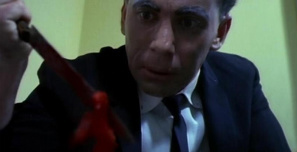
Blood Feast would be the logical conclusion to Alfred Hitchcock’s Psycho, released three years earlier. Whereas the earlier classic had featured the subtle and suggestive shower scene, Lewis’ effort would begin with an explicit sequence in which a young girl is stabbed in the eye whilst laying in the bath, briefly revealing her breasts (something with Hitchcock had only hinted at). This statement seemed to be that whilst Psycho had flirted with the notion of terror, Blood Feast was the real deal. To help develop his story, Lewis drafted in the talents of Allison Louise Downe, his new wife and star of his nudie pictures, often working under the aliases Vicki Miles and Bunny Downe. Despite having no previous writing experience, Lewis entrusted her with the task of adapting their premise into a workable screenplay, which would be a blood splattered concoction of gore, nubile young women and a rather bizarre Egyptian subplot.
For his cast and crew, Lewis would pillage his back catalogue for actors and artists to help bring his twisted imagination to life. The role of Detective Pete Thornton, the cop in charge of the investigation, the director enlisted the talents of William Kerwin, his star of nudie flicks The Adventures of Lucky Pierre and Boin-n-g, who would be credited under the name Thomas Wood. Mal Arnold, who would portray Blood Feast‘s deranged antagonist Fuad Ramses, had previously appeared as a nudist in Nature’s Playmates. For the part of Suzette Fremont, the key victim of the story, the producers cast Connie Mason, a twenty-five year old employee of Playboy, who would be crowned Playmate of the Month shortly before the film’s release. Lewis had found her when visiting the Playboy Club to look for a suitable actress for the opening murder at the request of Friedman, but had been suitably impressed enough to cast her on the spot. Coincidentally, the following year Mason and her co-star, Kerwin, would marry and later have two children, though sadly he would pass away from a heart attack in 1989 at the age of sixty-two. Scott H. Hall, who would be cast as the police chief, was not a professional actor but had been given the part after their original choice failed to arrive at the set. Unable to act, Lewis instructed him to simply shout his lines instead.
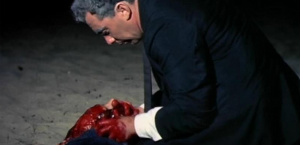
Blood Feast would focus on a spree of gruesome murders which would result in its victims being severely mutilated. As the radio station warns young women to become more vigilant, the killer strikes again, slicing out a girl’s eye to add to his collection. The violator is Fuad Ramses, a deranged caterer who is gathering artefacts from his victims to offer as sacrifice to Ishtar, an Egyptian and Syrian goddess worshipped five thousand years ago. The police are clueless, always one step behind the killer, moving from one bloody aftermath to another. Meanwhile, Dorothy Fremont is searching for a suitable caterer for a birthday party she is planning for Suzette, her sweet and innocent daughter who, ironically, is studying Egyptian culture. But can the detective in charge solve the investigation and hunt down the culprit before any more young women are slaughtered, and what will Suzette’s birthday surprise have in store for her.
To prepare for Blood Feast, the filmmakers formed a new production company entitle Friedman-Lewis Productions, which would also later be responsible for their subsequent effort Two Thousand Maniacs!. With a budget of approximately $24,500, shooting commenced in Miami, Florida during March 1963 for nine days. Due to the lack of funds, there were no rehearsals prior to filming and each scene would only warrant one take, forcing actors to get their lines perfect the first time. In an effort to avoid unnecessarily costs on crew members, Lewis would fill the roles of cinematographer and composer himself, whilst creating the makeup with the help of Downe. The blood and gore was created by using Kaopectate, a diarrhoea remedy which was dyed with red and then applied to the actors, although they avoided telling them exactly what the formula consisted of. For the sequence in which a young girl has her tongue removed, the filmmakers purchased a sheep’s tongue which they had shipped in from Tampa. But due to a power shortage resulting in the refrigerator remaining warm, the tongue had begun to smell and would prove unusable for the scene, until Hall coated it with pine sol, a pine oil-based cleaning product.
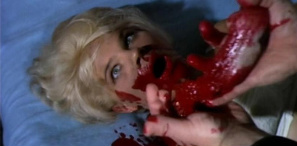
For Ramses’ delicatessen, the producers located a Syrian grocery store in which the crew were able to shoot at on days when the business was closed. For the beach in scene, in which a young girl, Marcy (played by London-born Playmate Ashlyn Martin), is brutally murdered, the sequence was shot outside the Suez Motel on Sunny Isles Beach in northeast Miami. The manager of the hotel had invited all of his guests out onto the beach in order to watch the filming of the scene but tragedy struck when the assistant cameraman opened the camera to discover that there was a thousand feet of unexposed film, resulting in an entire night’s shooting and a large sum of the budget wasted. Both Lewis and Friedman would cameo in the picture, as the Radio Announcer and Drunken Husband, respectively, although surprisingly Downe would not appear in the movie, despite continuing to act once the film was completed in the likes of Scum of the Earth and Suburban Roulette.
Once filming had been completed, post-production immediately commenced with the editing chores being handled by Frank Romolo and Robert L. Sinise, father of future CSI: NY star Gary Sinise. Blood Feast had its premier on July 6 1963 in Peoria, Illinois, with the local release handled by Chicago theatre owner Stan Kohlberg, before being passed onto a North Carolina distributor by the name of Harry Kerr. The movie was heavily edited during its Los Angeles run, although the MPAA had passed the film through uncut, believing that it would soon disappear and thus was not worth the effort. One screening in Des Moines, Iowa, resulted in the reels being spliced together out of sequence, with the sixth once again being followed by the fifth, causing the audience to have to watch an earlier portion of the film once again instead of ending. A publicity stunt in Sarasota, Florida, in which Lewis and Friedman had anonymously taken out an injunction to keep the film from being screened, would backfire when the movie was denied permission to be shown in the town. Over the years, Blood Feast has become something of a guilty pleasure, as despite its bad acting and inferior script, its excessive violence and sleazy nature has resulted in it remaining a fan favourite.
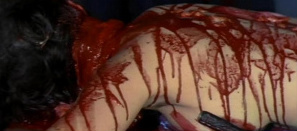

2 Responses to GODFATHER OF GORE – Blood Feast